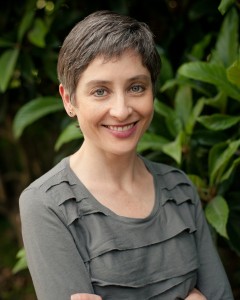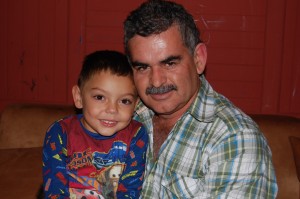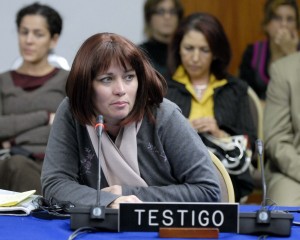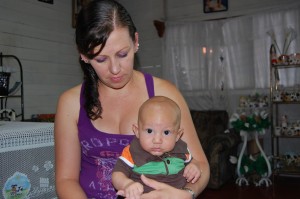Tags: Costa Rica, embryo, human rights, in vitro fertilization, infertility, IVF, religion, science, women's rights

‘Beautiful Sin’ producer and director Gabriela Quirós. Photo by Lenny Gonzalez.
What if you desperately wanted a baby, but your country and religion prohibited you from trying the one medical treatment that could help you conceive? Beautiful Sin tells the decade-long story of three couples struggling with infertility who take the Costa Rican government before an international human rights court to demand the right to use in vitro fertilization (IVF). Costa Rica is the only country in the world that has outlawed the fertility treatment, in which doctors create embryos in the lab.
In a region rocked by battles over reproductive rights, the story told in Beautiful Sin is without a doubt the strangest. In the year 2000, anti-abortion activists with the help of the Catholic Church and a U.S. group won a legal case that banned IVF in Costa Rica and gave the embryo legal rights. Beautiful Sin is a cautionary tale about what can happen when a religious ideology such as the “personhood of the embryo” becomes law.
For more information and to view the trailer, please click HERE. For broadcast information, please check all your local listings.
Beautiful Sin explores how Costa Rica became the only country in the world to outlaw in vitro fertilization, a fertility treatment in which embryos are created in a lab. What inspired you to tell this touching story?
Andrea Bianchi, Alberto Moreno and their children Camila and Alejandro are one of the three families that BEAUTIFUL SIN follows for a decade. Courtesy of Azul Films.
I grew up in Costa Rica and started my career in journalism there. I was a health reporter in 1995 when the first baby to be conceived through in vitro fertilization (IVF) in Costa Rica was born and I was one of the many reporters who covered the birth. It was a huge news event. BEAUTIFUL SIN opens with footage from the birth. And one of the things that I thought at the time was that it was ingenious how a very Catholic country, like Costa Rica, had been able to figure out a way to carry out IVF in a way that was mindful of sensitivities around the embryos created during IVF. The doctors were only allowed to fertilize a small number of eggs and they had to put all the resulting embryos into the woman. They couldn’t discard or freeze any embryos. Elsewhere, it was, and is, standard procedure to freeze embryos for later use, and embryos are sometimes disposed of. So Costa Rica was practicing IVF in a unique way.
A year later, in 1996, I moved to the Bay Area to study documentary filmmaking at the University of California, Berkeley. And in the year 2000 I was surprised when I read that Costa Rica had banned the treatment. I was intrigued by the situation: Here you have a medical treatment that’s designed to help couples have a child, and yet the government of a country is banning it with the argument that it puts fertilized eggs at risk. I wanted to understand why the ban had happened. What had changed and why wasn’t it OK for Costa Rican doctors to perform IVF, even in the very restricted way that they had been doing it? And I wondered how the ban was going to impact couples struggling with infertility.
The film depicts an intense political debate around the question of whether embryos should have legal rights or not. Do you think your film will have an impact on the current abortion debate in the U.S.?
BEAUTIFUL SIN follows María Calderón and five other patients in Costa Rica who take their government before an international human rights court to demand the right to use IVF. Courtesy of Azul Films.
Costa Rica’s Supreme Court banned IVF with the argument that the embryos created in the lab had legal rights and that if doctors placed, say, three embryos into a woman, and only one baby was born, the other two embryos’ right to life had been violated.
The question of whether embryos should or shouldn’t have legal rights has played a small role in the debate around abortion in the United States. A few pro-life activists in the U.S. have proposed “personhood amendments” at the state level. These are amendments to state constitutions that would give legal rights to embryos from the moment of fertilization. Activists have been successful at putting these amendments on the ballot in Colorado, North Dakota, Mississippi and other states. The amendments have lost in all of these states.
The contribution that Beautiful Sin can make to the conversation on whether embryos should or shouldn’t have legal rights is to show the potential consequences of putting this idea into practice. The difference between Costa Rica and the U.S. is that in Costa Rica pro-life activists specifically targeted IVF. They wanted to get the treatment banned and they succeeded. Here in the U.S., pro-life activists say that their ultimate goal in establishing legal rights for the embryo is to ban abortion, and that they have no intention of banning IVF. But infertile couples and fertility doctors have sounded the alarm saying, “wait a minute, it’s not a good idea to establish legal rights for the embryo because this could create a barrier to fertility treatments.”
Regulation for in vitro fertilization treatment is not uniform in Latin America. For example, one of the couples in the film, Andrea and Alberto, travel from Costa Rica to nearby Colombia just to receive IVF treatment. Why do you think Costa Rica is unique in the sense that it absolutely bans IVF while other Latin American countries have less regulation on embryo rights?
That’s a good question. I think this film shows just how extreme the Costa Rican ban on IVF is.
In your opinion, do you think the Costa Rican government will ever legalize in vitro fertilization? Why or why not?
Andrea Bianchi testifies before the Inter-American Commission on Human Rights, in Washington, D.C., on Oct. 28, 2008. Courtesy of the IACHR.
Yes, I think the Costa Rican government will eventually legalize IVF because the country is legally bound to do so by an international human rights court. But so far two different administrations have dragged their feet since 2010, when the Inter-American Commission on Human Rights, based in Washington, D.C., issued its recommendation that the country legalize IVF again. (In 2012, a second human rights body, this time the Inter-American Court of Human Rights, whose decisions are legally binding for Costa Rica, ruled that the country should legalize IVF).
Has Beautiful Sin screened in Costa Rica? If so, what was the audience reaction?
Not yet, but I’m working on getting the film broadcast in Costa Rica this year. The Spanish-language version of the film is called EL DESEO MÁS GRANDE.
What difficulties did you encounter during the making of Beautiful Sin?
Cryopreserved embryos at Reproductive Science Center of the San Francisco Bay Area, in San Ramon, California. Courtesy of Azul Films.
Fundraising was very difficult. This is a film that doesn’t fit neatly into any categories. Not that it’s easy for any documentary to get funded, but I think this one was particularly challenging because it’s about a group of men and women who want to have children. Many funders are interested in giving men and women access to contraception; others are working to help women give birth safely. And those are both important goals. But perhaps because infertile men and women are a minority, their needs aren’t prioritized and treatment is viewed as non-essential. Even here in the United States there are serious barriers to people who need IVF. There are very few states where insurance companies are required by law to cover IVF. As a result, the treatment is out of reach for many. Patient advocacy groups like RESOLVE are working to change this.
I’m very, very grateful to Latino Public Broadcasting, KQED Public Television, Chicken & Egg Pictures, my in-laws Marlene and Larry Gilbert, Hivos, Mama Cash, the Women in Film Foundation Film Finishing Fund, the Pacific Pioneer Fund and my friends for their contributions.
What do you hope your audiences will take away from the film?
It’s been very exciting to talk to audience members after screenings of BEAUTIFUL SIN and realize that they’re taking away exactly what I had hoped. This is a nuanced story about the place of religion and religious beliefs in public life. Is it possible to balance religious beliefs and scientific development? This is a question that comes up over and over again in so many realms, in so many countries. And the answers aren’t easy and they require lots of creativity on the part of lawmakers, activists and the public. I like to think that BEAUTIFUL SIN is a contribution to a big conversation on faith and science in modern life.
Why is public media the best platform to showcase this story?
Because public media, at its best, is a pluralistic place where viewers get to experience the world in all its complexity. And this is a complex story.
Can you tell us what project you’re working on now?
For the past eight and a half years I’ve been fortunate to work as a full-time video producer for the San Francisco Bay Area’s public broadcasting station KQED, in their science unit. I’ve produced for the TV science series QUEST and for the Web series Science on the SPOT and Deep Look. I’m lucky because I’m always working on something interesting. Right now I’m finishing a video about leafcutter ants, the ones you see carrying huge leaf pieces in the rainforest. They use those leaves to grow a fungus. Ants have been farming for 60 million years – much longer than us humans!
About the Filmmaker
Gabriela Quirós is a documentary filmmaker who has long covered the intersection of science, technology and social change. A staff producer since 2006 at KQED Public Television in San Francisco, she has produced and directed more than 50 segments and half-hour documentaries for the science series QUEST, and won two regional Emmys. She grew up in Costa Rica and worked there as a print reporter covering health, the environment and politics for Spanish- and English-language newspapers. She has master’s degrees in journalism and Latin American studies from the University of California, Berkeley.
In 1995, she covered the birth of the first baby conceived through in vitro fertilization (IVF) in Costa Rica. Five years later, by then settled in the Bay Area, she was surprised when Costa Rica – known as a verdant country that respects human rights – became the only nation in the world to outlaw IVF. She was drawn in by the impact the ban was having on couples struggling to conceive, and by the intense political battle around the question of whether embryos should have legal rights. Quirós ended up spending a decade investigating whether her country is capable of balancing religious faith and scientific development. The result is Beautiful Sin, her first feature-length documentary.
10468 Views









